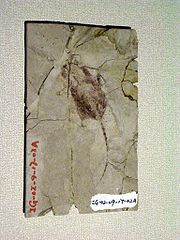
Jeholodens
Encyclopedia
Jeholodens was a primitive mammal
belonging to the Triconodonta
family, and which lived in present-day China during the Middle Cretaceous
about 125 million years ago.
Known only from a single specimen, the holotype consists of a virtually complete articulated skull and skeleton, it shared its corporal characteristics with most other Mesozoic
mammals; it was a long-tailed, nocturnal tetrapod
(with prehensile fingers and toes) which hunted insect
s, its food, during the night.
 It is suspected to be a nocturnal creature because it had very large eyes which were roughly 5 cm across. This would have allowed it to have better night vision for catching insects. It was a relatively advanced mammal for its time and had larger shoulders blades and collar bone; it also had grasping hands. It had forelimbs and it was likely to be capable of an upright stance.
It is suspected to be a nocturnal creature because it had very large eyes which were roughly 5 cm across. This would have allowed it to have better night vision for catching insects. It was a relatively advanced mammal for its time and had larger shoulders blades and collar bone; it also had grasping hands. It had forelimbs and it was likely to be capable of an upright stance.
According to "Biology" 9th edition by Mader, this mammal had the sprawling hindlimbs of a reptile but its forelimbs were under the belly, as in modern mammals.
More information is available at:
http://www.carnegiemnh.org/news/99-jan-mar/990322jeholodens.html
Mammal
Mammals are members of a class of air-breathing vertebrate animals characterised by the possession of endothermy, hair, three middle ear bones, and mammary glands functional in mothers with young...
belonging to the Triconodonta
Triconodonta
Triconodonta is the generic name for a group of early mammals which were close relatives of the ancestors of all present-day mammals. Triconodonts lived between the Triassic and the Cretaceous. They are one of the groups that can be classified as mammals by any definition...
family, and which lived in present-day China during the Middle Cretaceous
Cretaceous
The Cretaceous , derived from the Latin "creta" , usually abbreviated K for its German translation Kreide , is a geologic period and system from circa to million years ago. In the geologic timescale, the Cretaceous follows the Jurassic period and is followed by the Paleogene period of the...
about 125 million years ago.
Known only from a single specimen, the holotype consists of a virtually complete articulated skull and skeleton, it shared its corporal characteristics with most other Mesozoic
Mesozoic
The Mesozoic era is an interval of geological time from about 250 million years ago to about 65 million years ago. It is often referred to as the age of reptiles because reptiles, namely dinosaurs, were the dominant terrestrial and marine vertebrates of the time...
mammals; it was a long-tailed, nocturnal tetrapod
Tetrapod
Tetrapods are vertebrate animals having four limbs. Amphibians, reptiles, birds and mammals are all tetrapods; even snakes and other limbless reptiles and amphibians are tetrapods by descent. The earliest tetrapods evolved from the lobe-finned fishes in the Devonian...
(with prehensile fingers and toes) which hunted insect
Insect
Insects are a class of living creatures within the arthropods that have a chitinous exoskeleton, a three-part body , three pairs of jointed legs, compound eyes, and two antennae...
s, its food, during the night.

According to "Biology" 9th edition by Mader, this mammal had the sprawling hindlimbs of a reptile but its forelimbs were under the belly, as in modern mammals.
More information is available at:
http://www.carnegiemnh.org/news/99-jan-mar/990322jeholodens.html

